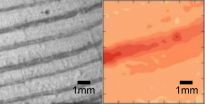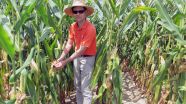Scientists reveal 'woodquakes'
Wood and its response to stress or strain has been less known at a fundamental level -- until now
2015-07-20
(Press-News.org) Wood and its response to stress or strain has been less known at a fundamental level - until now.
The structural properties of brittle materials like rock or ceramic, such as cracking under stress, have long been studied in detail, providing insight into avalanches, earthquakes and landslides. Wood and its response to stress or strain has been less known at a fundamental level - until now.
Scientists, from the Department of Applied Physics at Aalto University in Finland, have applied well-established methods for studying all kinds of materials to wood, namely through detailed observation and listening. Their results indicate that wood - while clearly different in its structure - behaves like other materials, showing patterns of damage and emitting a crackling sound in response to compression. Indeed, the sound we hear when we listen to wood is analogous to seismic waves released by earthquakes.
Doctoral candidate Markus Ovaska explains the experiment: "We took small pieces of pine and compressed them with a piston (1cm square) to create deformations in the wood. To observe the process, we used common techniques, that is, digital image correlation and acoustic monitoring of the deformations. These techniques were then correlated to provide us with the sight and sound of wood's properties as the compressions were made."
Some aspects in the behavior of wood have previously been overlooked. Dr. Amandine Miksic, one of the co-authors on the paper, explains: "It has long been assumed that wood is unique or that it displays specific properties, for example, due to its layered, cellular structure and year rings. By creating an experiment that observes wood using acoustic and optical measurements, we've found a universal pattern of response, similar to avalanches."
Every time we sit in a wooden chair, walk on a parquet floor, or drive across a timber bridge, "woodquakes" are happening below.
These woodquakes were unexpected, according to co-author Professor Mikko Alava, who supervised the project. "Since the properties of wood are so dependent on temperature or humidity, it is a surprise that we get these kinds of avalanches. We have to now ask whether this happens in all kinds of biological or natural materials."
Miksic suggests their results could contribute to predicting failure and perhaps prevent future damage, something vitally important to the furniture or construction industry.
INFORMATION:
Their findings will be published in the journal Physical Review Letters. The work was financially supported by the Academy of Finland's Centre of Excellence in Computational Nanoscience (project no. 251748). END
[Attachments] See images for this press release:

ELSE PRESS RELEASES FROM THIS DATE:
2015-07-20
Philadelphia, PA, July 20, 2015 - Exposure therapy is a commonly used and effective treatment for anxiety disorders, including posttraumatic stress disorder, obsessive-compulsive disorder, and phobias.
The goal of such therapy is to extinguish fear, which is accomplished by presenting cues that are known to predict a negative experience in the absence of that experience. Over time, learning that the 'danger cue' is no longer dangerous produces extinction of the fearful response.
However, fears and the associated defensive behaviors resulting from that fear often return ...
2015-07-20
FLORENCE - There are almost 275,000 acres of corn planted in South Carolina, with an economic impact of approximately $130 million. Though this is dwarfed by Midwest states such as Iowa (13.7 million acres, $8.75 billion), it's still a lot of corn - enough, at least, to make a person think S.C. would be a utopia for the insects that like to feast on tasty yellow kernels.
But instead of being a slice of paradise, a cornfield can often be a far-from-optimal host for pests such as the corn earworm. Francis Reay-Jones, an associate professor and research scientist for Clemson ...
2015-07-20
A new study from The University of Texas Health Science Center at San Antonio found that mothers with chemical intolerances are two to three times more likely than other women to have a child with autism spectrum disorder (ASD) or attention deficit hyperactivity disorder (ADHD).
The medical study was published in the July-August 2015 issue of the Journal of the American Board of Family Medicine.
People who are chemically intolerant often have serious reactions to common chemicals and some become too sick to carry out routine functions. Chemical intolerance affects about ...
2015-07-20
New research reveals that the more people think they know about a topic in general, the more likely they are to allege knowledge of completely made-up information and false facts, a phenomenon known as "overclaiming." The findings are published in Psychological Science, a journal of the Association for Psychological Science.
"Our work suggests that the seemingly straightforward task of judging one's knowledge may not be so simple, particularly for individuals who believe they have a relatively high level of knowledge to begin with," says psychological scientist Stav Atir ...
2015-07-19
(New York, July 18, 2015) Researchers from the NYU Langone Medical Center, NYU School of Medicine will present new findings at the 2015 Alzheimer's Association International Conference in Washington, D.C., July 18-23-2015.
The NYU Langone Alzheimer's Disease Center is comprised of the Center for Cognitive Neurology, Center for Brain Health and the Parkinson's and Movement Disorders Center.
It is one of thirty Alzheimer's disease research centers in the United States supported by the National Institute on Aging (NIA). As an NIA-supported research facility, the center's ...
2015-07-17
HER2 membrane proteins play a special role in certain types of breast cancer: amplified levels of HER2 drive unrestricted cell growth. HER2-tailored antibody-based therapeutics aim to prevent cancer cell growth. However, two-thirds of HER2 positive breast cancer patients develop resistance against HER2-targeting drugs. The reason for this is not yet understood. Researchers now found out, that HER2 dimers appeared to be absent from a small sub-population of resting SKBR3 breast cancer cells. This small subpopulation may have self-renewing properties that are resistant to ...
2015-07-17
SAN ANTONIO (July 17, 2015) -- Researchers from the School of Medicine at The University of Texas Health Science Center at San Antonio have found evidence that directly links disrupted metabolism (energy production in cells) to a common and often fatal type of lymphoma. The finding was announced Thursday (July 16) in Nature Communications.
"The link between metabolism and cancer has been proposed or inferred to exist for a long time, but what is more scarce is evidence for a direct connection -- genetic mutations in metabolic enzymes," said senior author Ricardo C.T. ...
2015-07-17
Lower levels of cholesterol in certain immune cells--a result of enhanced cholesterol metabolism within those cells--may help explain why some HIV-infected people are able to naturally control disease progression, according to research that will be presented in a poster at the 8th International AIDS Society Conference on HIV Pathogenesis, Treatment and Prevention (IAS 2015) in Vancouver, Canada, and the pre-conference 2015 Towards an HIV Cure Symposium. The findings provide a basis for potential development of new approaches to control HIV infection by regulating cellular ...
2015-07-17
Washington, DC - July 17, 2015 - The success of probiotics for boosting human health may depend partly upon the food, beverage, or other material carrying the probiotics, according to research published on July 10th in Applied and Environmental Microbiology, a journal of the American Society for Microbiology.
"Our findings indicate that the manner in which a probiotic is delivered--whether in food or supplement form--could influence how effective that probiotic is in delivering the desired health benefits," said corresponding author Maria Marco, PhD, an associate professor ...
2015-07-17
When a power company wants to build a new wind farm, it generally hires a consultant to make wind speed measurements at the proposed site for eight to 12 months. Those measurements are correlated with historical data and used to assess the site's power-generation capacity.
At the International Joint Conference on Artificial Intelligence later this month, MIT researchers will present a new statistical technique that yields better wind-speed predictions than existing techniques do -- even when it uses only three months' worth of data. That could save power companies time ...
LAST 30 PRESS RELEASES:
[Press-News.org] Scientists reveal 'woodquakes'
Wood and its response to stress or strain has been less known at a fundamental level -- until now

